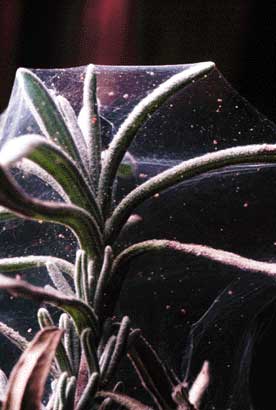Symptoms
As mites feed on leaf undersides, flower petals, bulbs or corms, and at blossom ends of fruit, they inject toxins into plant tissues, causing discoloration and distortion of these tissues. Suspect a mite infestation when upper surfaces of leaves closest to the soil are stippled with tiny white or yellow dots or red spots.
 |
The leaves or needles of infested trees and shrubs become dry, coppery colored, and curled slightly upward. Webs are visible. Certain mite species may cause galls, or lumps, to form the leaves or new shoots. Galls are abnormal growths caused by stimulation of plant tissue by the developing mite nymphs. On fruit trees, the fruit will look reddish, scorched. It may be dry, rough and deformed.
Diagnosing Mites
Most of the symptoms of a mite infestation can also be caused by Mites, thrips, leafhoppers, and even air pollution. To be sure the problem is mites check the undersides of plant leaves with a magnifying glass each week for mites and mite damage, starting at the bottom of the plant and working up. Tap 2 or 3 leaves (or a small branch tip) against a sheet of white paper and look for any dislodged mites, which look like dirty specks crawling on the paper. You are more likely to see their fine webbing rather than the actual mites. Other pests and poor environmental conditions do not make the webs.
Remember, mites are part of the normal life found in and around a healthy landscape. It is only when their numbers suddenly increase and threaten plants which begin to show the stippled, pale foliage and webs, that you need to intervene to control them.

